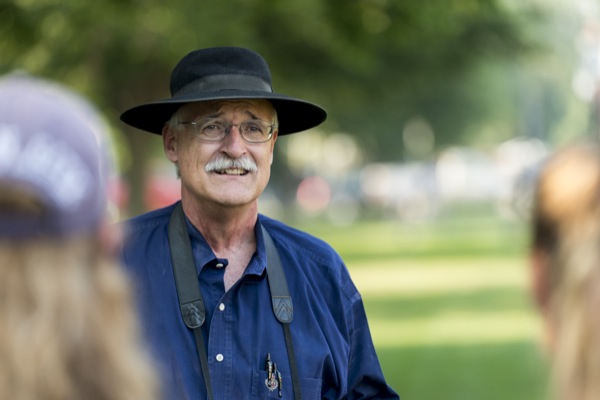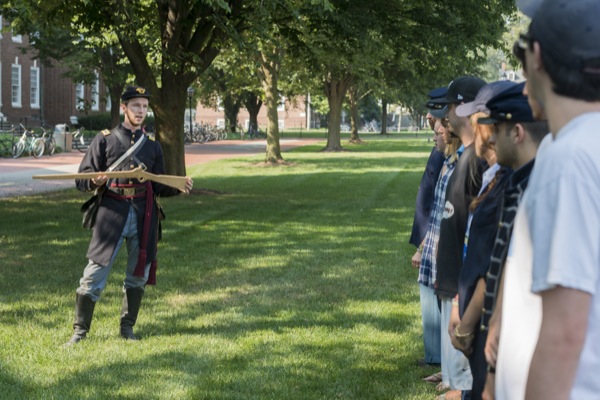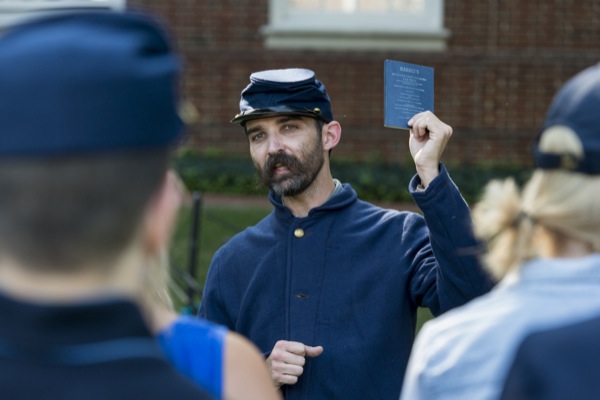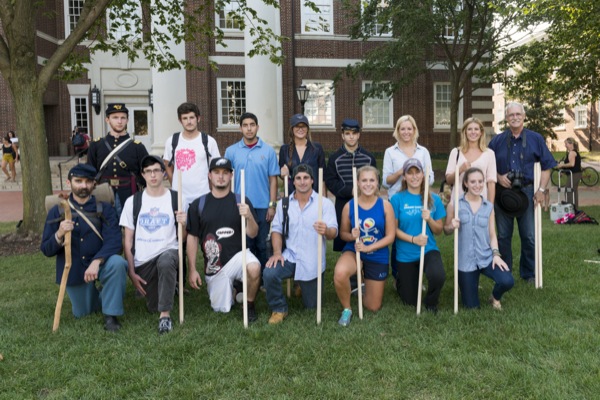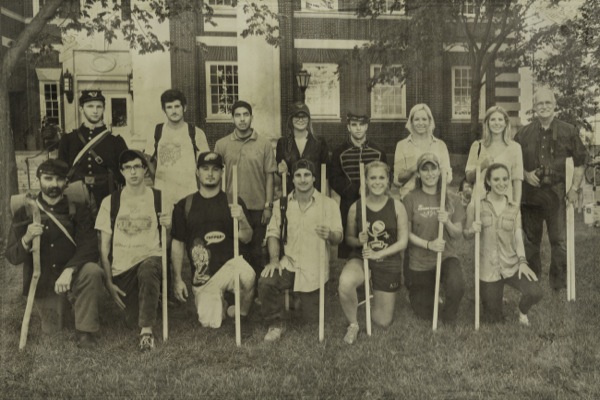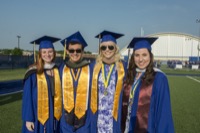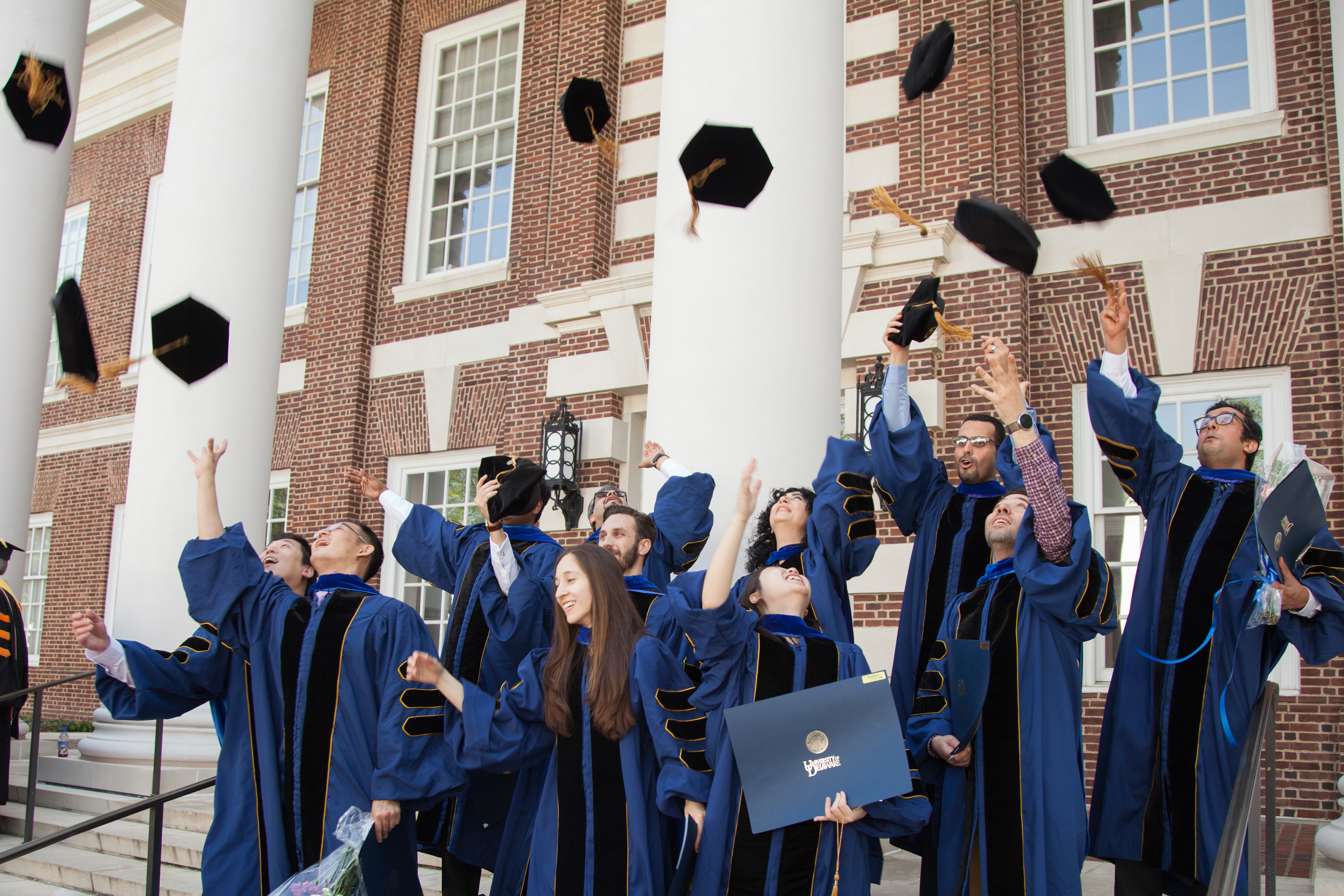

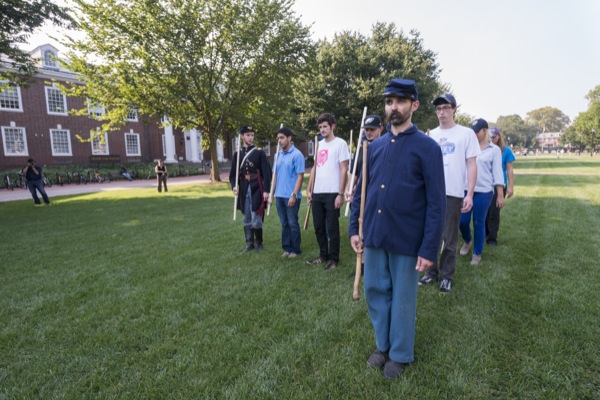
Civil War lessons
Prof. Ritchie Garrison's class learns Civil War lessons through experience
3:59 p.m., Sept. 16, 2013--Never mind that they were dressed in jeans and T-shirts, some in tank tops and running shorts. Never mind that they carried long wooden dowels instead of muskets, marching in formation on The Green and not a Civil War battlefield.
On a warm, late-summer afternoon, Ritchie Garrison’s History 411 students were learning drills and marches like Union soldiers.
Campus Stories
From graduates, faculty
Doctoral hooding
“I am going to let our officers issue non-lethal muskets, which I bought at Home Depot this morning,” said the smiling professor of history and director of the Winterthur Program in American Material Culture. He handed long wooden sticks to his two doctoral students, Lucas Clawson and Tyler Putnam.
Unlike the undergraduates, Clawson and Putnam were dressed the part. Clawson was a soldier, complete with full beard, forage cap and blue wool coat. Putnam, a second lieutenant, wore a Prussian-blue officer’s coat and kepi hat.
Both University of Delaware graduate students also happen to be Civil War re-enactors.
The day was one of the highlights of Garrison’s course, "The Emancipation Project," in which undergraduates are creating a digital version of a Civil War diary passed down to Garrison by his great uncle, John Ritchie, a quartermaster of the Massachusetts 54th Black Regiment.
Working with the History Media Center’s media specialist, Tracy Jentzsch, the students are helping make this diary accessible to everyone.
“They are proofreading the diary and writing a series of short papers, to be published alongside the diary to make it publicly available to anyone who would like to read it,” Garrison said. “They are crowdsourcing the information.”
Jentzsch filmed the students as they learned commands such as “right face” and “parade dress.” She and Garrison were impressed by how quickly the students learned the techniques. The video she took will become part of the digital project.
“Even though it’s an analog kind of day, they will turn this into a digital aspect when the students begin editing the video,” Jentzsch said.
A rare opportunity
For the students, the course is offering them a rare opportunity to work with original historical documents, publish their own research online for distribution, and to actually become a part of what they were learning, Garrison said.
On this humid day, sunlight dappling through the trees, the juniors and seniors listened intently as Clawson and Putnam taught them how to stand at “dress:” lined up closely shoulder-to-shoulder. They learned how to march with and without “doubling,” (side-by-side and in single-file) and how to “fall in” as they made their way across the lawn.
Like a unit-in-training, the students marched, taking their roles seriously. Some seemed nervous they wouldn’t respond correctly to a command.
The group drew attention from curious passers-by and some students waved nervously as friends walked past. Others giggled, proud to be there, marching and learning drills most students only ever read about.
“It’s very complicated,” said senior Connor Gerstley, a double major in history and English. “There is much more to this than I ever imagined.”
Garrison’s class had studied the Army Manual of Arms, but actually doing it really brought the lesson home for the class.
“You can read about it all you want,” he said to his students. “But you’ll always remember this day. You’ll be telling your grandbabies about it.”
The class learned how to handle their pretend muskets, responding to the commands given by Clawson and Putnam to “shoulder arms,” “present arms,” and “order arms.” There were many commands to learn and techniques to grasp.
“It takes a bit of coordination,” Clawson said, as the class learned to maneuver their weapons. “It’s a lot to keep in mind and a lot to do with your hands and these [pretend muskets] are light.”
During the war, soldiers in rank were packed closely together and having a good handle on their weapon could be a matter of life or death for them and their colleagues. Being close together allowed them to fire en masse, increasing their chances of hitting a target, and also conveyed unity and strength. But it also left them vulnerable to misfires and poor aiming abilities.
As the class members learned how to bring their muskets from ground to hip to shoulder in a ready position, Garrison told them to “look soldierly.”
“Looking soldierly is important not only for discipline,” Garrison said, “but also for safety.”
The role of African American soldiers
The experience that day, and throughout the course, was for another purpose, too. It was to teach the students about the role of African Americans soldiers in the Civil War and to examine how their service moved the needle ever-so-slightly on the racial prejudices of the time.
The diary from the Massachusetts 54th was one of two passed down to Garrison. The other came from his great-grandfather, George T. Garrison, who was an officer of the Massachusetts 55th Black Regiment.
Both were some of the first units made up exclusively of African American soldiers, led by white officers. Garrison said their service contributed to the “amelioration of racial prejudice.”
“The course project is to get students thinking about the way military experience shaped the lives of men who were African American,” said Garrison, noting most of the enlisted volunteers were freed slaves.
The soldiers, regardless of their skin color, were treated according to the same military standards. They drilled and trained just like their white counterparts and, for the most part, were treated with a good deal of respect from their officers.
By the end of the war, black men had begun to achieve the rank of sergeant and three out of the 100,000 African American men who served had earned first lieutenant status.
“It really did change people's opinions when black troops fought as well as white,” said Garrison.
The professor grinned from ear to ear as he watched his students -- graduate and undergraduate -- play out what the soldiers before them had more than 150 years ago. It was the first time he had done this with a class.
“I said to them: ‘This is going to be the most unusual course you take at this University,” said Garrison. “I never taught this class before but I knew when I taught it I wanted to do this.
“If you didn’t see it, you would never understand it.”
Senior history major, Allison Schulze, already couldn’t wait to tell her dad. She said she’d read all the orders, as Garrison had assigned, but being out on The Green, responding to “second lieutenant” Putnam helped her put everything in perspective.
Soldiers of the Civil War were in heavy wool clothes, often traipsing through oceans and swamps, with little light illuminating their way. They carried heavy muskets and often weren’t certain whether their weapons were even loaded.
“Here I am in a tank top and shorts and I’m sweating and getting bug bites,” Shulze said. “It’s hard enough with this [wooden stick] and it’s light. I can’t even imagine how hard it was.”
Article by Kelly April Tyrrell
Photos by Evan Krape




